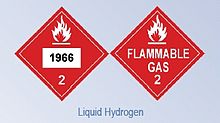LH2
|
|
|||
| Names | |||
|---|---|---|---|
|
IUPAC name
Liquid hydrogen
|
|||
| Other names
Hydrogen (cryogenic liquid); hydrogen, refrigerated liquid; LH2, para-hydrogen
|
|||
| Identifiers | |||
|
3D model (Jmol)
|
|||
| ChEBI | |||
| ChemSpider | |||
| KEGG | |||
|
PubChem CID
|
|||
| RTECS number | MW8900000 | ||
| UNII | |||
| UN number | 1966 | ||
|
|||
|
|||
| Properties | |||
| H2 | |||
| Molar mass | 2.02 g·mol−1 | ||
| Appearance | Colorless liquid | ||
| Density | 70.85 g/L (4.423 lb/cu ft) | ||
| Melting point | −259.14 °C (14.01 K; −434.45 °F) | ||
| Boiling point | −252.87 °C (20.28 K; −423.17 °F) | ||
| Hazards | |||
|
EU classification (DSD)
|
|||
| NFPA 704 | |||
| 571 °C (1,060 °F; 844 K) | |||
| Explosive limits | LEL 4.0%; UEL 74.2% (in air) | ||
|
Except where otherwise noted, data are given for materials in their standard state (at 25 °C [77 °F], 100 kPa).
|
|||
|
|
|||
| Infobox references | |||
 |
|
| RTECS | MW8900000 |
|---|---|
| PEL-OSHA | Simple asphyxiant |
| ACGIH TLV-TWA | Simple asphyxiant |
Liquid hydrogen (LH2 or LH2) is the liquid state of the element hydrogen. Hydrogen is found naturally in the molecular H2 form.
To exist as a liquid, H2 must be cooled below hydrogen's critical point of 33 K. However, for hydrogen to be in a fully liquid state without boiling at atmospheric pressure, it needs to be cooled to 20.28 K (−423.17 °F/−252.87 °C). One common method of obtaining liquid hydrogen involves a compressor resembling a jet engine in both appearance and principle. Liquid hydrogen is typically used as a concentrated form of hydrogen storage. As in any gas, storing it as liquid takes less space than storing it as a gas at normal temperature and pressure. However, the liquid density is very low compared to other common fuels. Once liquefied, it can be maintained as a liquid in pressurized and thermally insulated containers.
Liquid hydrogen consists of 99.79% parahydrogen, 0.21% orthohydrogen.
In 1885 Zygmunt Florenty Wróblewski published hydrogen's critical temperature as 33 K; critical pressure, 13.3 atmospheres; and boiling point, 23 K.
Hydrogen was liquefied by James Dewar in 1898 by using regenerative cooling and his invention, the vacuum flask. The first synthesis of the stable isomer form of liquid hydrogen, parahydrogen, was achieved by Paul Harteck and Karl Friedrich Bonhoeffer in 1929.
Room–temperature hydrogen consists mostly of the orthohydrogen form. After production, liquid hydrogen is in a metastable state and must be converted into the parahydrogen isomer form to avoid the exothermic reaction that occurs when it changes at low temperatures; this is usually performed using a catalyst like iron(III) oxide, activated carbon, platinized asbestos, rare earth metals, uranium compounds, chromium(III) oxide, or some nickel compounds.
...
Wikipedia



